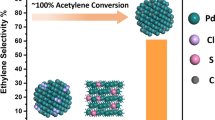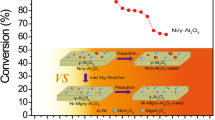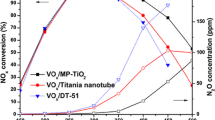Abstract
The support effect for HZSM-5 and Al2O3-supported chromium (Cr) catalysts on the catalytic decomposition of methyl mercaptan (CH3SH) is investigated. Characterization results reveal that the distribution, reducibility, oxidation states and coordination environment of chromium species mightily depend on the nature of support. Al2O3 support is covered by surface hydroxyl groups, thus conducing to the formation of monochromatic Cr(VI) species with tetrahedral coordination, which remarkably increases the reducibility and dispersion of chromium species. In contrast, plenty of inactive α-Cr2O3 particles are formed on the surface of Cr/HZSM-5 catalyst due to the lack of adequate hydroxyl sites. Furthermore, a positive correlation is established between the content of active Cr(VI) species and the number of surface hydroxyl groups over Cr/Al2O3 catalysts. Reactivity data suggest that the addition of chromium species can observably enhance the conversion of CH3SH for both two supports. More importantly, 5% Cr/Al2O3 catalyst features the superior catalytic performance at 400 °C (100% conversion). The promoting effect can be attributed to the high-content hydroxyl groups on Al2O3, which are proven to stabilize monochromatic Cr(VI) species. This result also provides evidence for the active sites of CH3SH decomposition reaction.
Graphic Abstract








Similar content being viewed by others
References
He C, Cheng J, Zhang X et al (2019) Chem Rev 119:4471–4568
He D, Zhao Y, Yang S et al (2018) Chem Eng J 336:579–586
Lu J, Hao H, Zhang L et al (2018) Appl Catal B Environ 237:185–197
Chen D, Zhang D, He D et al (2018) Chin J Catal 39:1929–1941
Abdullah A, Bakar M, Bhatia S (2006) J Hazard Mater 129:39–49
Yang P, Xue X, Meng Z et al (2013) Chem Eng J 234:203–210
Sinha AK, Suzuki K (2005) Angew Chem Int Ed 44:271–273
Cavania F, Koutyreva M, Trifiròa F et al (1996) J Catal 158:236–250
Yang P, Xue X, Meng Z et al (2015) Appl Catal B Environ 162:227–235
Chen D, He D, Lu J et al (2017) Appl Catal B Environ 218:249–259
He D, Wan G, Hao H et al (2016) Chem Eng J 289:161–169
He D, Hao H, Chen D et al (2017) Catal Today 281:559–565
He D, Zhang L, Zhao Y et al (2018) Environ Sci Technol 52:3669–3675
Zhao Y, Lu J, Chen D et al (2019) New J Chem 43:12814–12822
He D, Yu J, Mei Y et al (2018) Catal Commun 112:31–34
Yu J, He D, Zhao Y et al (2020) Mater Chem Phys 239:121952
Kumar MS, Hammer N, Ronning M et al (2009) J Catal 261:116–128
Su J, Yao W, Liu Y et al (2017) Appl Surf Sci 396:1026–1033
Ayaria F, Mhamdi M, Álvarez-Rodríguez J et al (2013) Appl Catal B Environ 134–135:367–380
Subhan F, Aslam S, Yan Z et al (2018) Chem Eng J 354:706–715
Cheng Y, Zhang F, Zhang Y et al (2015) Chin J Catal 36:1242–1248
Michorczyk P, Pietrzyk P, Ogonowski J (2012) Micropor Mesopor Mat 161:56–66
Cheng Y, Miao C, Hua W et al (2017) Appl Catal A Gen 532:111–119
Ye N, Li Y, Yang Z et al (2019) Appl Catal A Gen 579:44–51
Liu Q, Gu F, Lu X et al (2014) Appl Catal A Gen 488:37–47
Scierka S, Houalla M, Proctor A et al (1995) J Phys Chem C 99:1537–1542
Baek J, Yun H, Yun D et al (2012) ACS Catal 2:1893–1903
Asghari E, Haghighi M, Rahmani F (2016) J Mol Catal A Chem 418–419:115–124
Sun M, Du X, Wang H et al (2011) Catal Lett 141:1703–1708
Du W, Yin L, Zhuo Y et al (2015) Fuel Process Technol 131:403–408
Llunga AK, Meijboom R (2017) Appl Catal B Environ 203:505–514
Rahmani F, Haghighi M, Mohammadkhani B (2017) Micropor Mesopor Mat 242:34–49
Priya SS, Kumar VP, Kantam ML et al (2014) Catal Lett 144:2129–2143
Tabesh S, Davar F, Loghman-Estarki MR (2018) J Alloy Compd 730:441–449
Lan S, Guo N, Liu L et al (2013) Appl Surf Sci 283:1032–1040
Li GC, Liu YQ, Liu CG (2013) Micropor Mesopor Mat 167:137–145
Mahmoud HR (2014) J Mol Catal A Chem 392:216–222
He D, Zhang Y, Yang S et al (2019) ACS Sustain Chem Eng 7:3251–3257
Boningari T, Ettireddy PR, Somogyvari A et al (2015) J Catal 325:145–155
Li Y, Xu J, Qian M et al (2019) Environ Sci Pollut Res 26:15373–15380
Ek S, Root A, Peussa M et al (2001) Thermochim Acta 379:201–212
Mueller R, Kammler HK, Wegner K et al (2003) Langmuir 19:160–165
Acknowledgements
The National Natural Science Foundation of China (21667016, U1402233, 21767016 and 21267011) is gratefully acknowledged for financial support to this research work.
Author information
Authors and Affiliations
Corresponding authors
Ethics declarations
Conflicts of interest
The authors declare no conflicts of interest.
Additional information
Publisher's Note
Springer Nature remains neutral with regard to jurisdictional claims in published maps and institutional affiliations.
Electronic supplementary material
Below is the link to the electronic supplementary material.
Rights and permissions
About this article
Cite this article
Zhao, Y., He, D., Chen, D. et al. Investigating the Support Effect for Catalytic Elimination of Methyl Mercaptan: Role of Hydroxyl Groups over Cr-based Catalysts. Catal Lett 150, 2763–2773 (2020). https://doi.org/10.1007/s10562-020-03178-z
Received:
Accepted:
Published:
Issue Date:
DOI: https://doi.org/10.1007/s10562-020-03178-z




